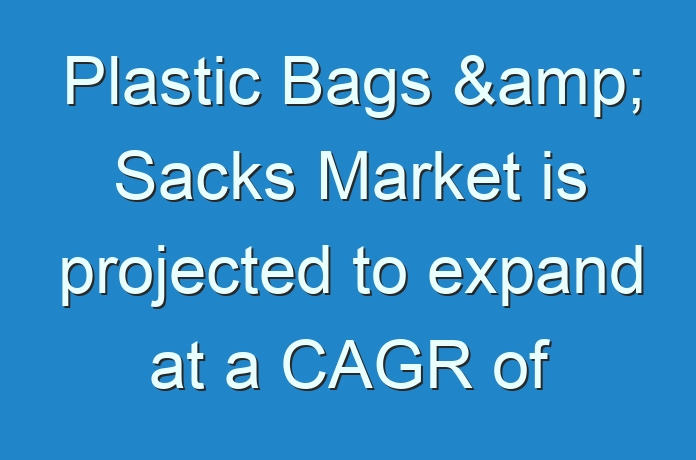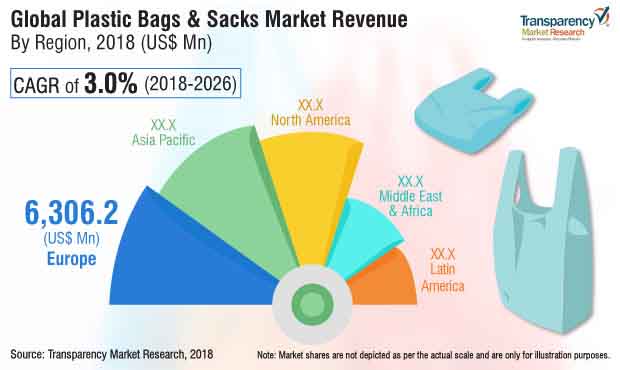
The global market for plastic bags & sacks was valued at US$ 19,866.5 million in 2017. The global plastic bags & sacks market value is projected to expand at a CAGR of 3.0% during the forecast period, 2018-2026.
The plastic bags & sacks are developed from two type of plastic materials, which are biodegradable and non-biodegradable. In 2017, more than 85% of plastic bags & sacks were manufactured from non-biodegradable materials such as HDPE, LDPE, LLDPE, PP, PS and other plastics. The non-biodegradable plastics are the highly preferred material for the production of plastic bags & sacks, due to cost effectiveness & abundant availability of the material. As compared to non-biodegradable plastics, biodegradable plastic
consumes large amount of resources for processing, leading to higher cost of the material. Biodegradable plastic bags & sacks are eco-friendly and decomposable as compared to the oil-based plastics (non-biodegradable plastic).
Request for a sample:
https://www.transparencymarketresearch.com/sample/sample.php?flag=S&rep_id=9284
Non-biodegradable plastic bags & sacks are expected to be highly attractive in terms of incremental opportunity and market share by the end of 2026. For manufacturing of non-biodegradable plastic bags & sacks, polyethylene material is most preferred. In 2017, more than half of plastic bags & sacks were made up of LDPE and HDPE plastics. Polypropylene plastic bags & sacks segment is expected to register a CAGR of 3.6% during the forecast period.
Europe region is estimated to be the largest geographic segment in the global non-biodegradable plastic bags & sacks market in 2018. In the European plastic bags & sacks market, LDPE & HDPE is expected to reach a cumulative market share of more than 60% during the forecast period. PS (Polystyrene) and other non-biodegradable plastic bags & sacks market segments are projected to witness sluggish growth during the forecast period. In Asia Pacific plastic bags & sacks market, HDPE is the highly preferred non-biodegradable plastic material for plastic bags & sacks. With the highest market share in Asia Pacific plastic bags & sacks market, HDPE material is also anticipated to create highest incremental opportunity as compared to other materials. Latin America and Middle East & Africa are expected to account for less than 15% of value share in the global plastic bags & sacks market in 2018.
Drivers and Restraints
In the present market scenario, the end-use plastic bags & sacks is not limited to the packaging of goods, but also for promoting the brand. Most of the leading supermarkets use plastic bags & sacks for promoting their brand. The use of plastic bags & sacks has increased among the retailers due high printability of plastic bags & sacks for providing detailed information about the product. As printed plastic bags & sacks are an effective marketing tool to promote brands, not only for the retailers, but also for the manufacturers of apparels, food & beverage, and other consumer products, have reflected an increased interest towards printed plastic bags & sacks. The plastic bags & sacks manufacturers offer customized printing options as per the demand of the consumer. The macroeconomic factors such as growth in disposable income and purchasing power of consumers are leading to an increased demand for plastic bags & sacks. The extra charges levied by the various government on the use of plastic bags & sacks acts as a restraint for the plastic bags & sacks market. In 2008, China imposed a ban on all thin plastic bags & sacks retailers and charged a tax on thicker bags. This led to a two-thirds reduction in the use of plastic bags & sacks. In 2015, Hong Kong imposed a levy that requires all retailers, from street hawkers to electronic appliance stores, to charge customers minimum 0.5 Hong Kong Dollar (US$ 0.064) for a plastic bag.

Competitive Landscape
Key players operating in the global plastic bags & sacks market are Berry Plastics Inc, Novolex Holdings, Inc. Mondi Group, Ampac Holdings, LLC, International Plastics Inc., BioBag International AS, PLAST-UP, Polykar Industries Inc, SPhere Group (Europe), Inteplast Group, Bischof & Klein GmbH & Co. KG, Hanoi Plastic Bag JSC, Symphony Polymers Pvt Ltd, Extrapack Ltd., Allstate Plastics LLC, BioBag Americas, Inc., MIRPACK, TM, Alpha Poly, Schur Flexibles Group, Starlinger & Co Gesellschaft M.B.H, Da Nang Plastic Joint Stock Company, Arihant Packaging, and Goglio Group.
Ask for brochure:
https://www.transparencymarketresearch.com/sample/sample.php?flag=B&rep_id=9284
Environmental Concerns Might Pose Threat to Growth of Plastic Bag and Sack Market
The global plastic bag and sack market is expected to witness a promising growth in the coming years of the forecast period. Rising demand from several end user application industries such as clothing and apparel, consumer goods, food & beverages, and grocery among others is among the key factor for increasing demand for these plastic bags and sacks. In addition to this, brands as well as retail stores primarily print their brand name along with other promotional and marketing messages on these plastic bags and sacks. Improving the use of these products as a low-cost but efficient marketing tool is also projected help the overall development of the plastic bag and sack market.
COVID-19 Impact
Like many other market, the global plastic bag and sack market felt the brunt of the outbreak of the COVID-19 global pandemic. The restrictions on movement, lockdowns, and other guidelines had a severe impact on the production. However, with rising demand for essentials and growth of e-commerce, the demand for plastic bags and sacks recovered from the initial slump. The market is expected to witness a steady growth in the coming years of the forecast period.
Read Latest Press Release By TMR:





